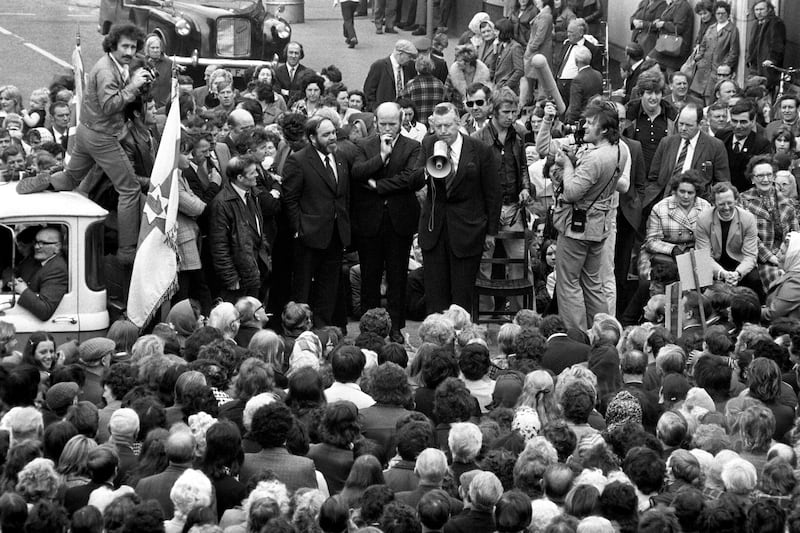Fifty years ago today, loyalists in the Assembly opposed to the Sunningdale Agreement formed themselves into the United Ulster Unionist Assembly Coalition, while maintaining their separate outside identities as Official Unionists, Vanguard and Democratic Unionists.
It was a follow-on from the unionist parliamentary coalition established in Westminster after the February general election (when the UUUC won 11 of the 12 Northern Ireland seats). The intention of the Westminster and Stormont coalitions was to both isolate and highlight Brian Faulkner’s pro-Sunningdale unionism (he didn’t even have a party at that point) as a minority political/constitutional interest.
A few weeks later the UUUC organised a three-day co-ordination conference in Portrush, at which about 100 unionist/loyalist politicians (including those with paramilitary links and others linked to the Orange Order and Ulster Workers Council) discussed the strategy required to bring down both the assembly and the Sunningdale agreement.

There was general agreement on nine demands: an extra 10 seats at Westminster; the return of a regional parliament within a federal UK; the devolution of powers over security from Westminster; the executive dissolved and replaced – temporarily – by direct rule; new assembly elections to be held by September; constituencies reduced in size to give independents a chance; voting papers to have names listed by random sampling and not alphabetically; the Council of Ireland rejected even as a topic for discussion; and after elections had taken place, the Secretary of State would be stripped of his power of veto.
It was clear from the outset that the UUUC knew most of the demands would be rejected. Indeed, it was essential they be rejected, because the UUUC didn’t want to get sucked into a negotiation with the government which might lead to divisions within their own ranks.
The trouble with a coalition that size – which collectively represented a considerable majority of unionism/loyalism – was that the government and MI5 (which was keeping a very close eye on the emergence of new voices and vehicles) would deliberately adopt a divide and destroy strategy.
- How Britain learned the lessons of the collapse of Sunningdale in 1974 – Alex KaneOpens in new window
- Northern Ireland Sunningdale Agreement at 50: Why the first major attempt at power-sharing was too-much, too-soon for unionistsOpens in new window
- Alex Kane: Unionist realignment must be more than jiggling the exiting bits aroundOpens in new window
It was also clear from the outset that the UUUC was determined to bring Northern Ireland to a standstill. It needed to flex its muscle and prove to both London and Dublin that it spoke for unionism and loyalism.
Leaving the assembly in place left open the possibility that people would get used it: get used to power-sharing with the SDLP (still viewed by most unionists as, to quote Vanguard leader Bill Craig, ‘first, foremost and always a party which will use every device to secure a united Ireland’). It was essential, in other words, that the life be sucked out of devolution, power-sharing and the assembly and not just out of the Council of Ireland.
It has been extraordinarily difficult to find out if the UUUC agreed any collective, thought-through analysis at all about what might follow the destruction of the ‘devolution experiment’ in 1974. We know that unionists were talking – albeit not conveying the same message – to successive NIO and Downing Street conduits in most of the period from late 1985 onwards; trying to tease out what would be acceptable in terms of restoring regional governance.

But in the mid-1970s – when the NIO was just getting to grips with unionism/loyalism and the often bizarre divisions therein – there probably weren’t enough people on either side of the conversations who understood enough about the nuances of working out what each wanted, let alone what each deemed to be even possible.
Craig himself told me that ‘we should have realised that a victory for unionism alone would never be a victory for the union or Northern Ireland’
I have talked to a handful of the people who were at that conference in late April 1974 and all have confirmed that the priority was the bringing down of the entire structures created at the time of the 1973 White Paper and assembly elections. Craig himself told me – and I’m paraphrasing from memory – that “we should have realised that a victory for unionism alone would never be a victory for the union or Northern Ireland”.

Fifty years on and there is another division between pro-agreement unionism and anti-agreement unionism. Today, though, the majority of unionists in the assembly support both devolution and the deal that restored it.
The antis, of course, will keep on pushing for rejection of everything; but like their majority predecessors in 1974 they don’t appear to have a thought-through alternative.




